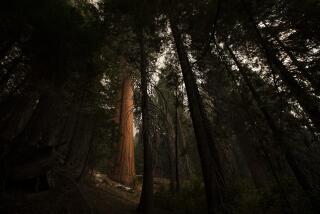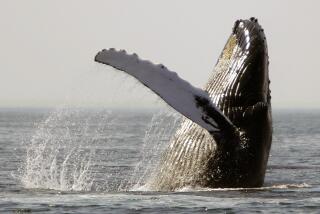As the planet gets hotter, some mammals may get smaller
- Share via
Fifty-six million years ago, about 10 million years after the dinosaurs went extinct, something strange happened to our planet.
It got hot.
For the record:
6:45 p.m. March 15, 2017A previous version of this post incorrectly made references to a hypothermal event. A rapid rise in temperature is a hyperthermal event.
Really hot.
Hotter than it had ever been since the Earth formed a few billion years earlier.
Carbon signatures in the geological record show that global temperature surged 5 to 8 degrees Celsius within 10,000 years.
They also indicate that the planet’s temperature remained elevated for an additional 170,000 years before returning to normal.
Scientists describe this (relatively) rapid rise in temperature as a “hyperthermal event,” and it is not the only one that has ever occurred.
About 2 million years later, the Earth experienced another surge in temperature that was about half the magnitude of its predecessor.
Over the course of Earth’s history there have been other, smaller hyperthermal events as well. Most scientists would agree that we are in the midst of one right now.
Abigail D’Ambrosia, a graduate student at the University of New Hampshire, is interested in what happens to living things when the global temperature jumps.
Do they go extinct? Do they adapt? Do they change?
Her research, published Wednesday in the journal Science Advances, shows that at least in the case of some mammals, they shrink.
And it turns out that the amount they shrink is directly related to how hot the planet gets.
The findings are based on a new analysis of fossilized teeth and jaw fragments collected from the Bighorn Basin in northwestern Wyoming, about 80 miles east of Yellowstone National Park.
“For adult mammals, measuring teeth is a great proxy for body size,” D’Ambrosia said.
By comparing the change in tooth size of the same species over time, researchers have already shown that mammal dwarfing occurred during the largest ancient warming event, approximately 56 million years ago.
Specifically, they showed that the earliest equid, Sifrhippus, shrank by at least 30% during the first 130,000 years of the warming event. As the global temperature slowly returned to normal, its body size rebounded by 76%.
D’Ambrosia, whose Twitter handle is @ClimateDentist, wondered whether similar dwarfing had occurred during the smaller warming event roughly 54 million years ago.
To find out, she set to work gathering and measuring teeth of four mammals that lived before and during it.
Included in her research was Arenahippus pernix (an early horse about the size of a small dog), Diacodexis metsiacus (a rabbit-sized predecessor of pigs and deer), Hyopsodus simplex (a weasel-sized herbivore) and Cantius abditus (an early primate similar to modern lemurs).
D’Ambrosia said that especially for the little horse, the difference in tooth size between individuals that lived before the warming event and those that lived during it was obvious.
“That was the coolest thing,” she said. “When I first started taking measurements my advisor started randomly grabbing teeth and guessing which came from the hyperthermal. Just visually, he could pick them out.”
(You can probably pick them out too. If you look at the picture at the top of this story, you will see D’Ambrosia holding two teeth from the same species. Can you guess which one lived during the warming event? The answer is in the caption.)
A scientific analysis of the data revealed that during the second warming event, Arenahippus shrank in size by an average of 14% — the equivalent of going from dog-sized to cat-sized, D’Ambrosia said.
This finding suggests that at least for equids, the dwarfing response to an increase in climate change scales proportionately with the magnitude of the warming. During the first warming event, the small horse decreased in size by 30%. In the second warming event, which was about half as intense, a different small horse dwarfed by 14%.
“These results are significant because they provide a new test of whether climate drives changes in body size in mammals,” said Jonathan Bloch, curator of vertebrate paleontology at the Florida Museum of Natural History, who was not involved in the study.
“Based on what we now understand about these repeated past experiments, it is becoming increasingly clear that one of the changes that we should expect to see with future global warming will be shifts in body size for some mammal lineages,” he said.
D’Ambrosia had fewer teeth from the other three species included in the study, but she was still able to report that Diacodexis, the deer predecessor, exhibited dwarfing of 15%. The change in size of the weasel-sized herbivore Hyopsodus was an insignificant 4%, and the primate Cantius bucked the trend by appearing to grow 2%. However, neither of these last two findings were significant.
“It’s hard to say what is going on in detail without collecting more samples,” D’Ambrosia said.
Although shrinking in the face of climate change may seem like a strange response, it is well known in scientific communities that mammals get smaller in warmer climates. For example, red foxes that live in higher, cooler latitudes are larger than those that live closer to the equator. This phenomenon even has its own name — Bergmann’s rule.
“The idea behind it is that it is more efficient to cool off if you have a small body size because you have a larger surface-area-to-volume ratio,” D’Ambrosia said.
This ratio allows smaller animals let off more heat, while having a larger body size in a cooler environment helps an animal retain heat.
But she added that it is also possible that animals living through ancient hyperthermal events may have shrunk for other reasons, including not being able to get enough water or food.
As the planet continues to warm today, scientists may be able to see for themselves what drives the mammal dwarf response.
Ross Secord, a professor of vertebrate paleontology at the University of Nebraska who was not involved in the new study, said there is already evidence from museum collections of modern birds and mammals that some species have gotten smaller over the last century because of a warming climate.
“Unfortunately,” D’Ambrosia said, “today is a really great experiment.”
Do you love science? I do! Follow me @DeborahNetburn and “like” Los Angeles Times Science & Health on Facebook.
MORE IN SCIENCE
Your kids aren’t killing you; one day they may actually help you live longer
UPDATES:
March 17, 6:45 p.m.: This story has been updated to include comments from vertebrate paleontologists Jonathan Bloch and Ross Secord.
This story was originally published on March 15 at 5:20 p.m.







